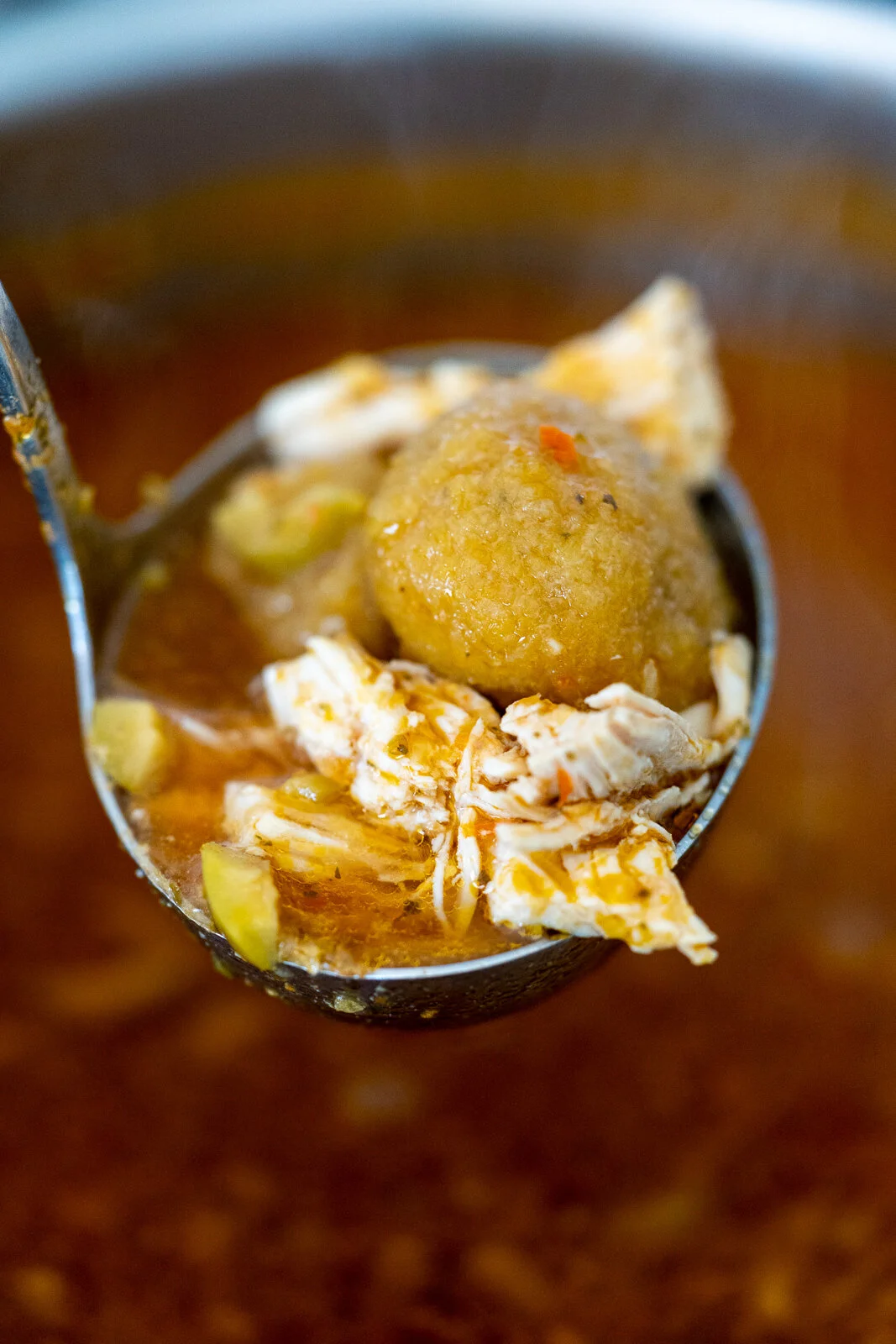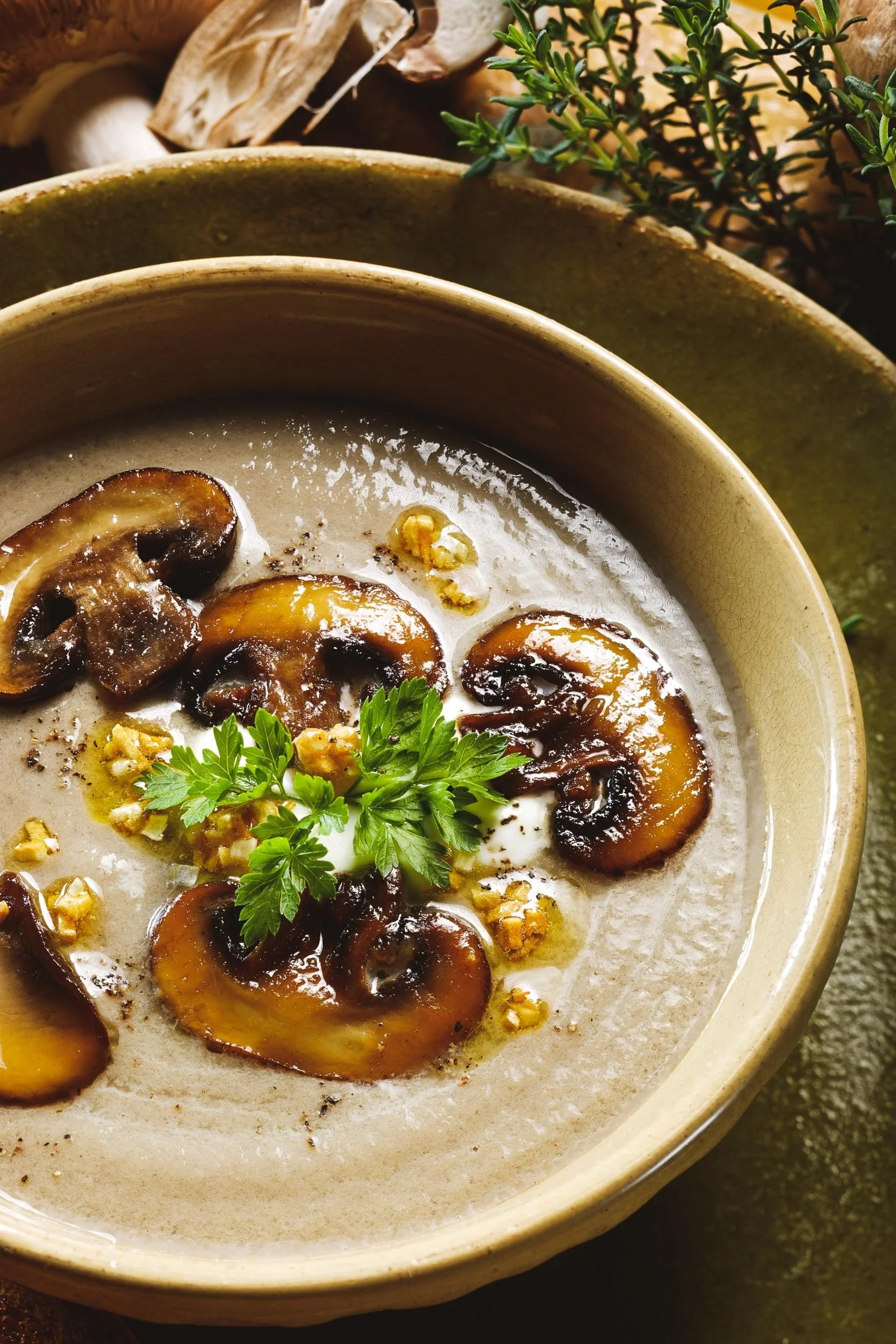This chicken and dumpling soup is inspired by the Puerto Rican asopao de gandules con bolitas, replacing the beans with chicken and omitting the rice to make a gluten-free, Paleo, and Whole30 meal. The bolitas (dumplings) are made from green plantains and not any type of flour. The broth is infused with the flavor of an authentic sofrito, made with culantro (or cilantro), garlic, red bell pepper, onion, and oregano. It is a hearty, filling soup that tastes great year round and comes together easily on a busy weeknight.
This hearty soup is inspired by the soups and stews that my Puerto Rican mother-in-law has cooked for me. During my most recent trip to see her, which was sadly due to the death of my father-in-law, she taught me how to make asoapo (kind of like a gumbo, with rice as a primary component) with bolitas, or plantain dumplings.
I was blown away by how easy the plantain dumplings were to make and how much character and delicious flavor they added to the stew. Bonus? They are naturally Paleo and Whole30!
While I plan to share her asopao con gandules (pigeon peas) recipe, I wanted to first share a Paleo soup that utilizes these magical plantain dumplings. Since I am from Georgia, classic southern style chicken and dumplings are in my DNA.
This is not meant to be a Paleo-ified version of Southern style chicken and dumplings. Instead, it is bursting with Puerto Rican flavor thanks to the aromatic sofrito cooking base. But it warms your heart and sticks to your ribs just like a southern chicken and dumplings recipe.
While I do cook with Paleo flours like cassava, coconut, almond, tapioca starch, etc., I prefer to use whole foods any time I can and reserve flours for special occasions. So in the case of chicken and dumplings, I favor the idea of using grated green plantain to make the dumplings, rather than a flour-based concoction.
How to make bolitas, green plantain dumplings
Milagros taught me to use a fine grater, like a microplane, to create the dough for the dumplings. The texture is softer, smoother, and it really does not take that much extra time to do compared to using a machine.
If you don’t want to use all that elbow grease, you can use a food processor to puree the green plantain. When I tested this, I processed, scraped the sides down, then repeated 3 more times to get the smoothest dough possible.
You can keep the dumplings plain or add some seasonings to them, it’s up to you. They will soak up the flavor from the broth as they cook.
You don’t want to overcook the dumplings, and they have the best texture when eaten fresh, but you can certainly eat this soup leftover and it is still delicious.
How to make Puerto Rican sofrito
This is a quick sofrito recipe that makes just enough for the soup. For a more robust recipe that makes a large batch you can freeze for later, plus more recipes that use sofrito and many more of Milagros’s family recipes, please check out my first best-selling cookbook, Latin American Paleo Cooking.
This recipe for sofrito is based on what my mother-in-law, who is from Arecibo Puerto Rico, taught me to do and is authentic to her family. Other families may have different recipes for sofrito, and that’s just fine!
Culantro vs Cilantro
Culantro and cilantro are two different herbs, although they have a similar flavor, and are botanical cousins.
They look quite different: culantro is a long flat leaf with serrated edges, while cilantro has skinny stems with a few scalloped leaves coming off of branches from the main stem. My mother-in-law calls it “long cilantro” sometimes.
Culantro leaves. Different herb than cilantro, although the flavor is similar.
Culantro holds its flavor much better when cooked compared to cilantro, and has undertones that are reminiscent of other herbs, like oregano and thyme. It also has a stronger flavor than cilantro, so if you must substitute with cilantro you have to use more.
You’ll find culantro at international grocery stores. It is used in some Asian cuisines (definitely Vietnamese, as I have been served culantro with pho at restaurants before) in addition to Caribbean cooking.
I have seen it labeled as “ngo gai” at Vietnamese grocery stores before, and other names for the herb include recao, shadow beni, and Mexican coriander.
¡Buen Provecho!
Enjoy! If you make it please tag me on social media @thecuriouscoconut and use the hashtag #thecuriouscoconut
Puerto Rican Chicken and Plantain Dumplings

Ingredients
- 1/2 of a red bell pepper
- 1/4 of a yellow onion
- 4 leaves culantro (or 1/2 bunch cilantro)
- 1 tsp fresh oregano (or 1/2 tsp dried)
- 3-4 cloves of garlic, peeled
- 1/2 tsp fine sea salt
- 1/4 tsp freshly cracked black pepper
- 1 tbsp extra virgin olive oil
- 1/4 cup extra virgin olive oil
- 1 1/2 lbs boneless, skinless chicken breast, cut into bite-size pieces
- 4 cups chicken broth
- 4 cups water (or more broth)
- 1 large carrot, peeled and sliced
- 1/2 of a red bell pepper, chopped
- 1/4 of a yellow onion, chopped
- 2 tbsp tomato paste
- 15 pitted green olives, sliced
- 3 green plantains
- 4 cloves of garlic, minced
- 1/4 tsp fine sea salt
- 1/4 tsp freshly cracked black pepper
- 1 tsp fresh oregano, minced (or 1/2 tsp dried)
For the Quick Sofrito:
For the Soup:
For the Dumplings (Bolitas):
Instructions
- Make the sofrito by combining all of the ingredients in a food processor or blender and pulse to make a smooth sauce.
- Heat a large (5 quart or larger) pot with a lid over medium heat for several minutes, until properly preheated. Add the ¼ cup of olive oil and the sofrito and cook, stirring occasionally, for about 3 minutes, and enjoy the fragrant aroma as it simmers. Stir in the chicken and cook for 5 minutes, stirring occasionally until no pink remains on the outside.
- Pour in the broth, water, carrot, bell pepper, onion, and tomato paste. Bring to a low boil, reduce heat, then cover and simmer for 10 minutes.
- Meanwhile, make the dumplings. First, cut the tips off of the plantains and then peel them by scoring the peel with a knife down the length of the plantain on 2 or 3 sides, and then lift the peel away from the fruit below with your fingers (see video). If the peel does not come off easily, you can soak the scored plantains in a bowl of water with about 1 tbsp of salt in it for 10 minutes.
- Finely grate the peeled plantains with a microplane grater to make a dough, and mix it with the garlic, salt, pepper, and oregano. Alternatively, you can use a food processor. Make sure to process, scrape down the sides, and repeat 3-4 times until you have a very smooth dough. There is no need to clean the food processor out after making the sofrito if you are using it for the plantains.
- To form the dumplings, also called bolitas, put a little olive oil on your hands to prevent sticking, use a measuring tablespoon to scoop up the dough, and roll it between your hands to make a ball. Set the balls aside on a plate until they are ready to cook.
- After the chicken is cooked through, add the bolitas and green olives and let them simmer for 5-8 minutes. Do not overcook! The dumplings will float when they are done.
- Serve immediately. You can garnish the bowls with sliced avocado, cilantro, and/or a lime wedge. Leftovers are best eaten the next day. The plantain dumplings will change in texture when reheated and become tougher.
- Note: the video shows whole chicken breasts and not bite size pieces. The reason why I changed to chicken pieces is because the chicken soaks up much more flavor from the sofrito that way. Either method works, and the soup is still delicious if you make it like I did in the video. If using whole breasts, add them to the sofrito and let them cook for 3-4 minutes per side before continuing the recipe.
Details
Other Information
Cuisine: Puerto Rican
Keywords: weeknight Paleo recipes, fast and flavorful Paleo recipes, plantain dumplings, gluten-free dumplings, Puerto Rican sofrito recipe, chicken soup recipe, Paleo dumplings recipe, Puerto Rican chicken soup, gluten-free chicken and dumplings
Suitable for: Gluten-Free





















This gluten- and dairy-free green bean casserole is just as quick and easy to make as the original, but without the allergens and additives.